Al-Zaytouna Centre for Studies and Consultations held, on 12/7/2023, a panel discussion entitled “Resistance in the West Bank… Possible Tracks” with the participation of a selection of experts and researchers specialized in the Palestine affairs.
Al-Zaytouna General Manager Prof. Dr. Mohsen Mohammad Saleh made his opening remarks, stating that this panel discussion is held in light of the escalation of armed resistance in the West Bank (WB), and in light of the Israeli aggression on Jenin and the hotbeds of resistance.
First session was headed by the editor-in-chief of Assabeel newspaper, ‘Atef al-Joulani, which started by the participation of Husam Badran, the member of Hamas Political Bureau. Badran stressed that this war was a battle of wills between the Palestinians and the occupation, and that what distinguishes the current resistance in WB from other uprisings is its diversity, i.e., there were individual and organized resistance operations. This time, he added, the number of Palestinians pursued by the occupation forces in this limited area has increased significantly. He added that the options are now open for the resistance, either it continues with these resistance operations or decreases them. On one hand, their continuation would be due to the absence of any looming political solution; the weak political, security and economic performance of the Palestinian Authority (PA); the adoption of resistance movements a number of resistance operations, after they were considered individual ones; the participation of many Fatah members in the latest clashes; and the increase of public support for the resistance. On the other hand, these operations may decrease due to the absence of a comprehensive resistance strategy, as there is no national consensus; the resistance is limited to specific areas; Israeli occupation has been violent with the resistance fighters and has pursued them; the Israel-PA security coordination; and the international and regional support of the occupation. Badran said that to expand the resistance action, more support is needed, in addition to bearing collectively the consequences of the resistance, whether by supporting the families of those killed or those whose homes were demolished. Furthermore, popular solidarity must be maintained, and a minimum level of national consensus to confront the occupation must be reached. At the end, he stressed that Hamas is interested in the continuation of these operations, whatever the consequences are.
The second paper was presented by Ihsan ‘Ataya, the member of the Palestinian Islamic Jihad Movement (PIJ) political bureau. He also stressed that all options are open for the resistance, and that the confrontations with the occupation and the unity of the arenas have proved that resistance is not limited to a specific area. They are a clear message to the occupation that it will not be allowed to deal with one area without the others interfering, and that it will not be able to eliminate the resistance in WB unless it eliminates the resistance in Jenin. ‘Ataya added that the most important goals of the Jenin operation were striking the resistance and preventing it from developing military capabilities; restoring Israel’s deterrence image in front of the world; and improving Israel’s fraying image due to its internal crises. However, Israel failed to reach these goals. He explained one of the most important factors of the resistance victory in Jenin is the unity of the field resistance, and added that the resistance is in a continuous battle with the Israeli enemy and all options are open, however, he ruled out the Israeli re-attack of the Jenin refugee camp (RC), so as not to repeat the same failures, and said that Israel will choose other less costly options.
The third paper was by the Director-General of the Palestinian Centre for Policy Research and Strategic Studies (Masarat), Hani al-Masri, who said that the future of the resistance in WB depends on the PA’s role and whether it will side with the occupation or with the Palestinian people. It depends also on the Palestinian opposition whether it will adopt a framework and a front that has a single vision and strategy, or will remain united just in the field, while having multiple visions and strategies; and it also depends on the future of the resistance brigades and lone-wolf fighters, will they get organized and benefit from previous experiences, without taking risks, while seeking political and leadership cover, or not? Al-Masri suggested setting a major national goal that would organize the Palestinian movement at this important stage, which is ending the occupation of the 1967 occupied territories, a goal that could be agreed upon by various parties. He added that the future of the WB resistance will also be affected by the changes in the region and the world; such as the possibility of Saudi Arabia normalizing it relations with Israel, the outcome of the Ukrainian war, and the outcome of the internal Israeli crisis. Al-Masri believes that one must rule out the demise of Israel in the short term for several reasons, including that the Israeli internal system despite its weaknesses is still strong, and that the US and the West will not allow its demise.
The fourth paper was by Brig. Gen. Dr. Amin Hoteit, specialist in the military affairs and university lecturer, who discussed the Israeli capabilities in confronting the Palestinian resistance, and the Palestinian capabilities of resistance action. He discussed the most important obstacles facing the resistance in WB, such as security coordination, the complexities of obtaining weapons and others. Hoteit suggested several scenarios concerning the WB resistance, and said that the Israeli-PA security coordination, the Israeli strict security measures that limit the resistance action, and the Israeli limited security operations in retaliation to major losses in its ranks, would all remain.
The second session was headed by Ahmad Atawneh, head of the Vision Centre for Political Development, and it started with Sari ‘Orabi, the researcher and author in Palestinian affairs, who presented the fifth paper. He said that assessing the state of resistance in WB becomes problematic when comparing it to Gaza or the previous Intifadahs, adding that dealing with each stage of the resistance as if it is a separate one is also problematic. ‘Orabi added that the resistance must take into account that Israel has developed its control and isolation methods of the WB infrastructure. He stressed that the causes for unrest in WB are still there, such as the storming of al-Aqsa Mosque, the crimes of the settlers, settlement building, lone-wolf resistance operations, resistance culture, the attempt to duplicate the case of Jenin RC in other places, and the PA weakness that fuels resistance action. ‘Orabi said that despite all the obstacles, the Palestinian resistance is in a state of escalation or ebb and flow, and that the resistance in WB will not end.
The sixth paper was presented by Prof. Dr. Walid ‘Abd al-Hay, the renowned futures studies expert, who said that we should not focus on the human losses, which are mostly in favor of Israel, rather we should focus on the impact of resistance on the Israeli economy, foreign investment, immigration or emigration and the image of Israel in international and Israeli public opinion. ‘Abd al-Hay divided the international position during and after the battle into four levels: The countries that had clear unambiguous support for the Palestinian resistance; those that equated between the victim and the executioner; those that remained silent; and international governmental and non-governmental organizations. However, what is common between these four groups is their failure to take any actual action against Israel. ‘Abd al-Hay believes that Israel wants to make WB a model for the future of Gaza Strip. He expects that the confrontations would continue in WB, while Israel would employ the increasing number of resistance hotbeds in Jenin, Nablus and Hebron, and the sporadic operations in villages or in cities, to make influential international forces pressure the PA for more security coordination. This situation would push Western countries to link their PA funding to the increase of security coordination, which the PA is expected to comply with.
The seventh paper was presented by Jawad al-Hamad, director of the Middle East Studies Center in Amman. He said that there may be escalations of popular resistance and armed confrontations in WB, however, they won’t expand significantly due to the Israeli policy that limits the confrontations within certain places as a prelude to containing them, not to mention that the security coordination with the PA is ongoing. Al-Hamad said Palestinians must overcome the political and geographical fragmentation. They must reconcile, work on popular resistance and develop combat capabilities in GS and WB.
The eighth paper was presented by Dr. ‘Adnan Abu ‘Amer, the researcher and author in Israeli affairs, who wondered about the goal of the resistance in WB, whether is it to exhaust Israel or to end the conflict. He considered that having weapons in the WB confrontations has relatively neutralized the populist dimension, and added that the WB resistance is supported in many forms, by the GS resistance and parties abroad. Abu ‘Amer said that Israel’s strategy is to intensify the aggression against WB, merge several scenarios, prevent other arenas from participating in the confrontations and rely on the PA to eradicate the WB resistance. He stressed the importance of not hastening the development stages of resistance and confrontations, and that the resistance must develop a strategy that would expand its scope, and not remain limited to a specific geographical area. This is the way to exhaust Israel and prevent it from striking painfully the Palestinians and making them pay hefty price, in terms of lives lost and infrastructure destroyed, he added.
Researchers, scholars and experts discussed the papers, with important interventions and questions, and the session was concluded by the answers and clarifications of the main panelists.
Al-Zaytouna Centre for Studies and Consultations, 14/7/2023









Leave A Comment